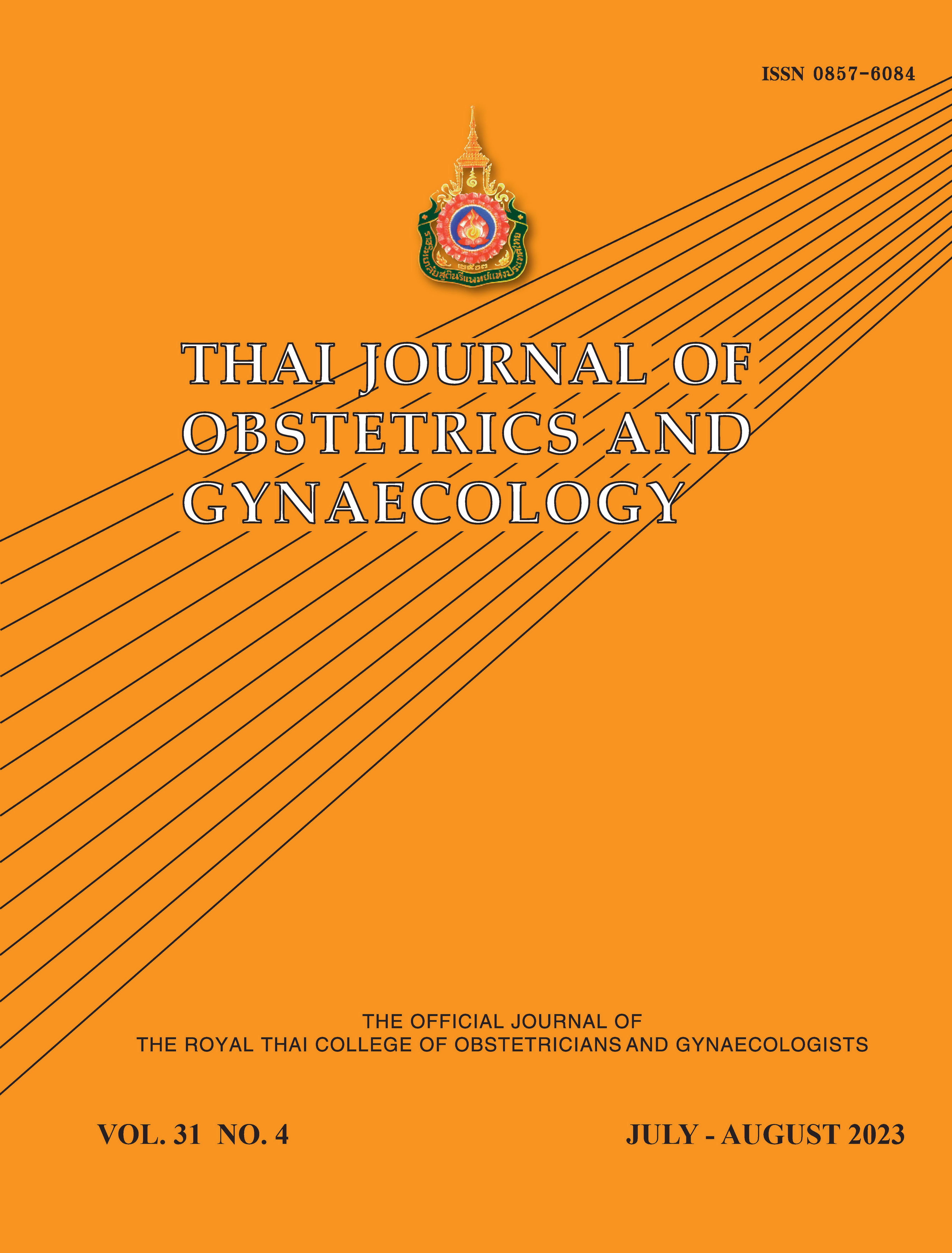Association between Chemiluminescent Microparticle Immunoassay Signal-to-cutoff Ratio and Active Stage of Syphilis in Thai Pregnant Women
Main Article Content
Abstract
Objectives: To demonstrate the association between chemiluminescent microparticle immunoassay (CMIA) signal-to-cutoff (S/CO) ratio and active stage of syphilis as well as adverse perinatal outcomes.
Materials and Methods: A retrospective chart review was conducted in pregnant women with reactive CMIA (CMIA S/CO ratio ≥ 1) as the primary test in the reverse algorithm of syphilis screening. The participants were categorized into three groups: Group 1 CMIA+ venereal disease research laboratory (VDRL)+; Group 2 CMIA+ VDRL- Treponema pallidum haemagglutination test (TPHA)+; and Group 3 CMIA+ VDRL- TPHA-. CMIA S/CO ratio and perinatal outcomes were compared. Active stage of syphilis refers to having venereal disease research laboratory (VDRL) titer ≥ 1:8.
Results: Eighty-three out of 8,987 (0.92%) pregnant women who came for antenatal care at Siriraj Hospital between January 2020 and February 2021 were reactive for CMIA. Two twin gestations were excluded. The CMIA S/CO ratio was highest in group 1 (n = 39) at 23.1 ± 5.5, followed by 16.1 ± 5.2 in group 2 (n = 25) and 2.1 ± 3.2 in group 3 (n = 17), p < 0.001. Perinatal outcomes were not different among the groups, except for congenital syphilis (CS). All six neonates with CS were born to the participants in group 1 who had CMIA S/CO ratio ≥ 19.9. Most of the participants who delivered neonates with CS were diagnosed with syphilis in third trimester and had VDRL titer ≥ 1:8.
Conclusion: Instances of adverse perinatal outcomes and active stage of maternal syphilis were more frequent in pregnant women with higher CMIA S/CO ratio. The use of CMIA S/CO ratio as an adjunct to clinical evaluation may provide additional benefits to the syphilis screening.
Article Details

This work is licensed under a Creative Commons Attribution-NonCommercial-NoDerivatives 4.0 International License.
References
Bureau of Epidemiology. Department of Disease Control. National Disease Surveillance (Report 506), Ministry of Public Health, Bangkok; 2012-2021. (Accessed 30 January 2022) Available from: http://doe.moph.go.th/surdata/disease.php?ds=37
Rungmaitree S, Mokkhamakkun C, Phongsamart W, Lolekha R, Wittawatmongkol O, Lapphra K, et al. Incidence of and factors associated with congenital syphilis at a tertiary hospital in Bangkok, Thailand. Southeast Asian J Trop Med Public Health 2019;50:1090-101.
Workowski KA, Bachmann LH, Chan PA, Johnston CM, Muzny CA, Park I, et al. Sexually transmitted diseases treatment guidelines, 2021. MMWR Recomm Rep 2021;70:1-187.
Centers for Disease Control and Prevention. Sexually transmitted infections treatment guidelines, 2021. United States; 2021. (Accessed 3 December 2022) Available from: https://www.cdc.gov/std/treatment-guidelines/syphilis.htm
Panchalee T, Chayachinda C, Panyakat W, Chen M, Quinones-Garcia V Z, Pernsoongnern P. Characteristics and neonatal outcomes of teenage pregnant women diagnosed with syphilis at Siriraj Hospital. Siriraj Med J 2018;70:298–301.
Centers for Disease Control and Prevention. Syphilis testing algorithms using treponemal tests for initial screening---four laboratories, New York City, 2005--2006. MMWR Morb Mortal Wkly Rep 2008;57:872-5.
Centers for Disease Control and Prevention. Discordant results from reverse sequence syphilis screening--five laboratories, United States, 2006-2010. MMWR Morb Mortal Wkly Rep 2011; 60:133–7.
Gratrix J, Plitt S, Lee BE, Ferron L, Anderson B, Verity B, et al. Impact of reverse sequence syphilis screening on new diagnoses of late latent syphilis in Edmonton, Canada. Sex Transm Dis 2012;39:528-30.
World Health Organization. WHO guideline on syphilis screening and treatment for pregnant women. Geneva: World Health Organization; 2017.
Division of AIDS and STIs. Prevention and management of mother-to-child transmission of syphilis guideline. Bangkok: Department of Disease Control, Ministry of Public Health, Bangkok;2021. (Accessed 27 September 2021) Available from: http://klb.ddc.moph.go.th/dataentry/handbook/form/128
Bangrak STI Center. National Guideline for Syphilis Testing: Laboratory Manual for Diagnosis and Monitoring. Bangkok, Bangrak STI Center; 2021. (Accessed 27 September 2021) Available from: http://klb.ddc.moph.go.th/dataentry/handbook/form/117
Seña AC, White BL, Sparling PF. Novel Treponema pallidum serologic tests: a paradigm shift in syphilis screening for the 21st century. Clin Infect Dis 2010;51:700-8.
Dai S, Chi P, Lin Y, Zheng X, Liu W, Zhang J, et al. Improved reverse screening algorithm for Treponema Pallidum antibody using signal-to-cutoff ratios from chemiluminescence microparticle immunoassay. Sex Transm Dis 2014;41:29–34.
Boonchaoy A, Wongchampa P, Hirankarn N, Chaithongwongwatthana S. Performance of chemiluminescent microparticle immunoassay in screening for syphilis in pregnant women from low-prevalence, resource-limited settings. J Med Assoc Thai 2016;99:119-24.
Zofkie AC, Seasely AR, Gaffney D, Rogers VL, Mcintire DD, Roberts SW, et al. Syphilis immunoassay signal strength correlates with active infection in pregnant women. Am J Perinatol 2020;37:671-8.
Chayachinda C, Chinhiran K, Chaithongwongwatthana S, Kittiyaowamarn R, Thamkhantho M. Elimination of congenital syphilis: what’s new for obstetricians in the 2020 Thai National Guideline? Thai J Obstet Gynaecol 2021:29;2-9.
Adhikari EH, Frame IJ, Hill E, Fatabhoy R, Strickland AL, Cavuoti D, et al. Abbott ARCHITECT Syphilis TP chemiluminescent immunoassay accurately diagnoses past or current syphilis in pregnancy. Am J Perinatol 2020;37:112-8.
Li Z, Feng Z, Liu P, Yan C. Screening for antibodies against Treponema pallidum with chemiluminescent microparticle immunoassay: analysis of discordant serology results and clinical characterization. Ann Clin Biochem 2016;53:588-92.
Tong ML, Lin LR, Liu LL, Zhang HL, Huang SJ, Chen YY, et al. Analysis of 3 algorithms for syphilis serodiagnosis and implications for clinical management. Clin Infect Dis 2014;58:1116-24.
Totten YR, Hardy BM, Bennett B, Rowlinson MC, Crowe S. Comparative performance of the reverse algorithm using Architect Syphilis TP Versus the traditional algorithm using rapid plasma reagin in Florida’s Public Health Testing Population. Ann Lab Med 2019;39: 396-9
Thornton C, Chaisson LH, Bleasdale SC. Characteristics of pregnant women with syphilis and factors associated with congenital syphilis at a Chicago Hospital. Open Forum Infect Dis 2022;9:ofac169.


